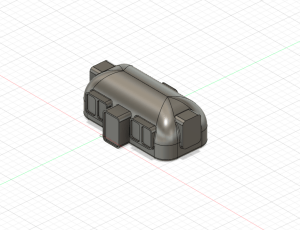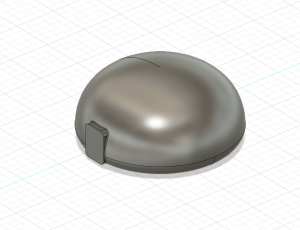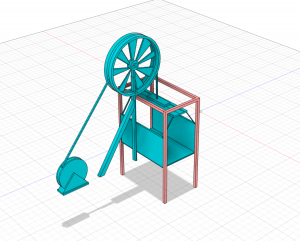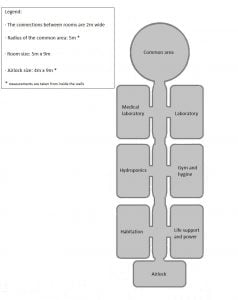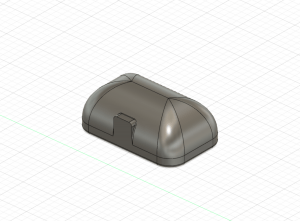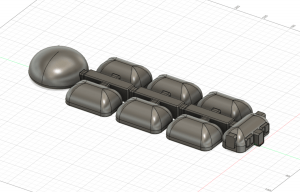|
Where do you want to build your Moon Camp?
Our moon camp will be located in a cave on the moon, one formed by volcanic activity long
ago. We thought that was the most advantageous location, because it will protect the
astronauts from dangerous elements of the space, such as micrometeorites and radiation. By
being below ground, impacts from meteorites would not be an issue, and much of the
radiation would be absorbed by the regolith and rock above it.
In addition, the tunnels are quite large, so it offers us an adequate amount of space for our
lunar base.
The access to the base will be through an elevator that will also have the capacity to transport
vehicles, protecting them too from the dangers of the moon’s surface
How do you plan to build your Moon Camp? Describe the techniques and materials you would use.
For our design we chose an inflatable base, as it is faster to build than other options, it is
prefabricated and requires little structural support, making it lighter and less voluminous than
other methods when in transport.
The wall of each module is made up of a mix of several interwoven fabrics for insulation,
structure (kevlar) and pressure. Ultimately it would use a similar composition as the Bigelow
Expandable Activity Module (BEAM) which is currently docked to the ISS. They will also
have a rigid aluminium base anchoring them to the ground, and an inward-opening door that
connects to other modules.
To enter the base crewmembers will use the airlock, where dust and other contaminants are
removed before entering the rest of the base. The airlock module has four suit ports, where
special spacesuits are docked from behind, never actually entering the base, further avoiding
the issue of fine dust. In addition, two ports on either side of the module allow for docking of
pressurized rovers.
Because of the modular design the base can be built in subsequent missions, with the most
important rooms (life support and habitation) near the front; it would also allow the crew to
rearrange or expand the base, similarly to the ISS.
Each room will have a purpose. There is a habitation module, a life support and power
module, a gym and personal hygiene room, hydroponics and biology laboratory, one
multipurpose lab and a medical lab, and a large common room for the crew or for
mission-specific objectives. The wide corridors also have much space for shelves and storage.
The environment on the Moon is very dangerous for the astronauts. Explain how your Moon Camp will protect them.
1. Meteorites: although lots of technology has been developed to protect astronauts from
small, fast objects from destroying spacecraft, the most effective solution is also the simplest.
By constructing the camp inside a cave below the surface, micrometeorites can be avoided
entirely, allowing sensitive equipment and unpressurised storage to remain outside the base
without the risk of irreparable damage.
Long caverns stretch across certain areas of the moon as a result of volcanic activity; when
the lava cooled it left behind long tunnels with large craters or “skylights” to the surface. A
large enough tunnel would be required, at least 20 metres wide, 10m tall and 50m long;
current data suggest that far larger tunnels could be found in multiple places. As long the
modules are placed far enough inside the tunnel the risk of impact would be near to none.
Anything that remains on the surface could be buried under a layer of regolith to absorb the
impact of smaller meteorites.
2. Radiation: radiation poses a big risk for astronauts, as it can cause cancer and other such
illnesses, as well as interfere with the operation of electrical equipment and communication.
Luckily, our decision to build the camp underground kills two birds with one stone, as the
dense and thick rock and regolith of the surface absorbs most of the solar and cosmic
radiation. Even so, crew cycles would be limited to no more than 1 year, like on the ISS, to
reduce the crew’s exposure and limit damage to health.
In addition, the inflatable modules and the rovers would incorporate passive radiation
protection, with a layer of polyethylene plastic. Other dense fabrics or even covering the
inflatable modules with lunar regolith could be considered, if further reducing exposure to
radiation is necessary.
Explain how your Moon Camp will provide the astronauts with:
|
|
Water will be brought from earth at the beginning, in large tanks. Also, water can be obtained
by gathering ice from the surface with rovers or unmanned vehicles, which would mine and
purify the water, bringing it back to the large tanks on the surface or smaller tanks at the base.
Water recycling would also be important, so a system like the one on the ISS would be used to
recover liquids from the crew’s urine and waste water, purifying it so it can be reintroduced;
water that is not clean enough for the crew might be useful for the hydroponics. Also, the
sabatier reaction can be used taking advantage of the CO2 exhaled by the crew and combined
with hydrogen, to produce water; this capability was proven aboard the ISS in 2014, and it is
able to produce up to 2000 litres per year.
|
Food is essential for the crew’s survival, but bringing it from earth might not be the only
option. First of all, yes, the majority would come from earth. Vacuum packed and dehydrated
food is the default for all spaceflight for obvious reasons, there’s no arable land on the moon.
Thanks to its long shelf life a tailored menu of prepared food can be brought from earth at the
beginning of each mission, with the exception of some ingredients that could be sent for
cooking at the camp; cooking, even with dried ingredients, could provide a great boost in
morale for the crew, who will be enduring a harsh environment. Additionally, food can be
grown to enrich the diet with fresh lettuce, microgreens, tomatoes, herbs and other plants that
grow well in hydroponics, providing vitamins and fresh produce.
|
Power is the lifeblood of any space mission, as everything relies on it. Because solar panels
do not work during the lunar night, which can last between 14 and 180 days according to
latitude, it is not a viable option. Given the lack of alternatives, only nuclear power is reliable
and powerful enough for such purposes; with radioisotope thermoelectric generators and
fission reactors as the two options. Because of the camp’s size, a fission reactor such as the
russian TOPAZ II is the optimal solution, as it can provide upwards of 10kW of power for a
relatively low cost and a weight of approximately 1 metric ton. The reactor core would be
buried below ground and inside the lava tube, with cables connecting it to the base and
surface. Additional reactors can be added if necessary, giving the base redundancy in the case
of failure. Despite this choice, solar power would be used for recharging the rover while it is
on an expedition; furthermore, backup solar panels would be stored, ready to be deployed on
the surface in case of an emergency.
|
Air is important for the astronauts, and it is made of two essential components, oxygen and
nitrogen. With a readily available supply of water, oxygen will be produced by electrolysis
with systems similar to those on submarines or the ISS (Elektron), producing hydrogen as a
useful byproduct for the Sabatier reaction, or refuelling spacecraft. As a backup, oxygen
candles can also be used in the absence of water, as were used aboard the MIR space station.
With oxygen out of the way, nitrogen is easy as it is an inert gas which is not consumed by
human activity; small tanks of pure nitrogen delivered from the earth can be used to maintain
pressure at all times. To keep the air breathable, CO2 must be removed by “scrubbing” it from
the air and venting it, or repurposing it in the Sabatier reaction.
|
|
Explain what would be the main purpose of your Moon Camp (for example: commercial, scientific, and/or tourist purposes).
The main purpose of the moon camp would be for scientific investigation which will aim to
learn more about the moon and the viability of future human habitation, for scientific,
commercial or tourist purposes.
The astronauts will study how to adapt human life to the moon’s environment and prepare for
humanity’s next steps in human spaceflight and extraterrestrial habitation, with the goal of
allowing humans to live off the land in future missions, with no need for supplies from earth.
It will also be a place to perform important scientific experiments, to study the moon with
experiments in chemistry, physics, astrophysics, geology, medicine and biology.
|
|
Describe a day on the Moon for your Moon Camp astronaut crew.
Crew members wake up at 7am and get ready for the day. At 7:30am, breakfast is served by
the crew member assigned to meal preparation for the week, who wakes up at 6:30am to
prepare it. At 8:00am, after breakfast and tidying up, each member begins their work day. The
crew is divided in two, half of them starting with menial chores such as cleaning and tidying
for the first half hour, followed by a 2,5 hour workout which serves to reduce muscle and
bone loss while in the low gravity environment of the moon. They then have a 20 minute
shower break before getting back to work. From 11:20 until lunch time at 13:30 they prepare
for their “professional” activities, by setting up experiments, preparing tools for maintenance,
performing medical checks on themselves or others, making preparations for spacewalks, etc.
The lunch break is from 13:30 to 15:00, when the crew prepares food and eats together.
In the afternoon each member of the half-crew group performs their assigned professional
activities, which include performing experiments laboratory, on the hydroponics module,
analysing medical exam results, performing maintenance inside or outside the station,
unloading or loading cargo, checking life support systems, or even departing and returning for
expeditions which have an approximate duration of one week. These activities continue until
20:00h, when the workday finishes and crew members eat dinner. Because the crew is split in
two, the morning and afternoon activities will be reversed for one half, starting with the
professional activities, cleaning up the experiments after lunch, cleaning afterwards and
working out before dinner. The rest of the day, until 22:00h, is for recreational purposes. This
free time can be spent in the common area, in the gym or in the habitation module. Past
22:00h the crew is encouraged to go to bed, allowing for a healthy 8-9 hours of sleep. On
Sundays, Saturdays or Fridays (allowing for various days of rest according to religion) the
crew has the day off and is not required to work out, spending time video chatting with their
family, enjoying hobbies or simply reading a good book.
The average crew consists of, ideally: one trained surgeon, one botanist, one chemist, one
physicist, one geologist, a nuclear engineer, a flight engineer and one more crew member of
any scientific field.
|


